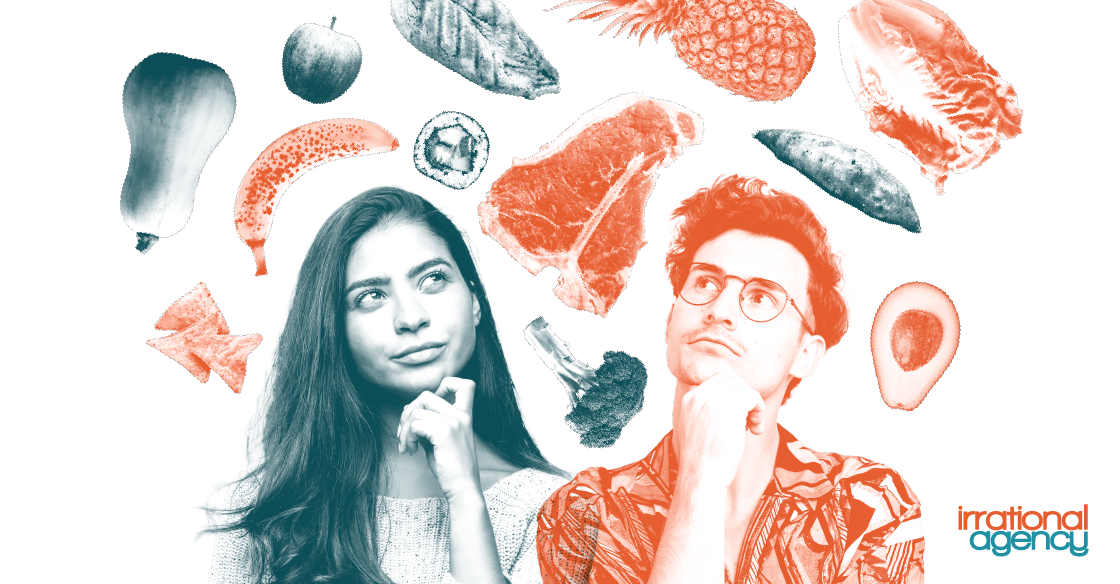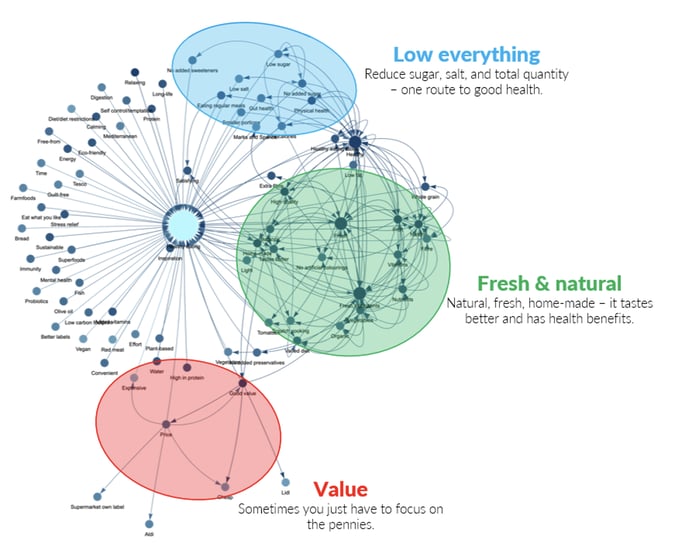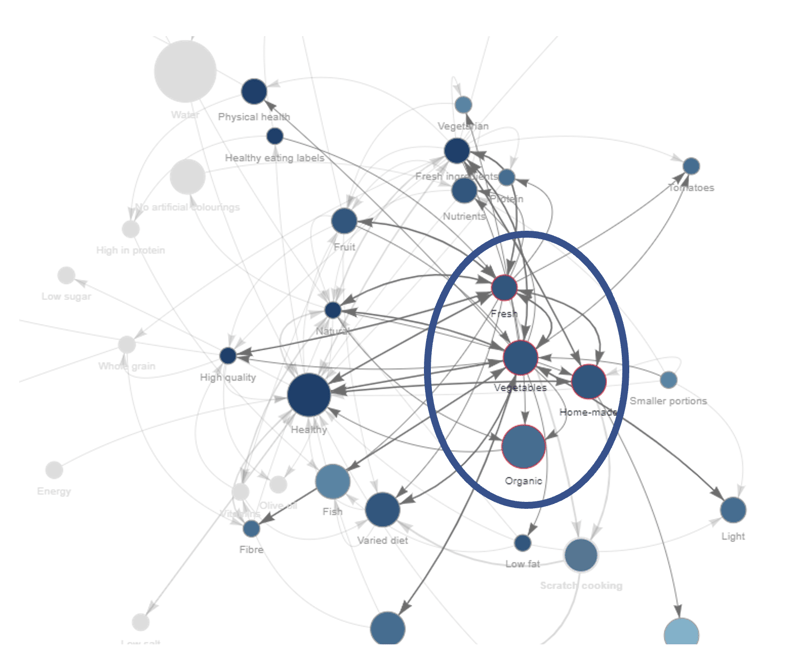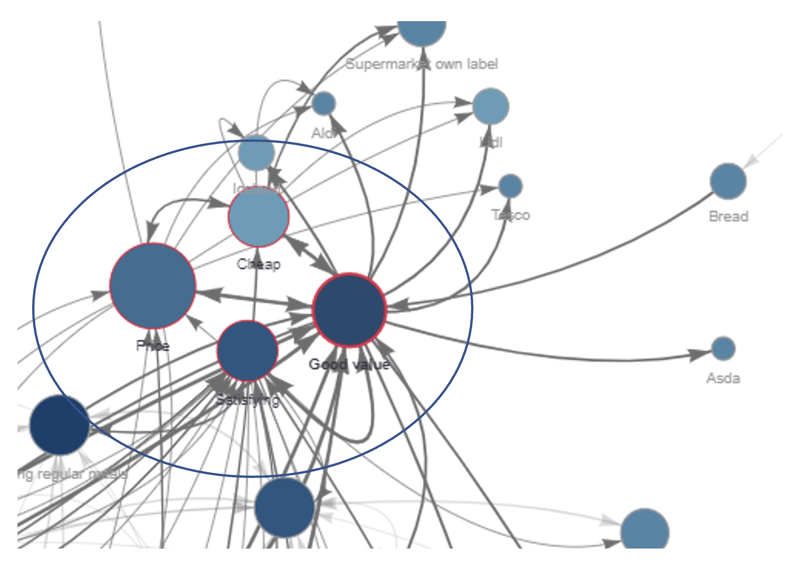
What do Consumer Stories Tell us About how Different Demographics see “Healthy"?
 Irrational Agency
Irrational Agency
“I would try to make a balanced meal, probably salad but with some sort of protein. But I’d put fruit in the salad to make it look attractive. I think my friend would be happy with that, they would want to avoid stodgy food. I would just need to keep her away from the wine and the crisp box!”
Catchy taglines, witty slogans and effective product descriptions rely on using language that resonates with us. But different words carry different associations for different consumer segments. How can we be certain the words we choose to describe a product will convert to consumer buying behaviors in our target audience?Every package, product description, and image you see, conjures up a scenario in your imagination. Words don’t just describe a product, they carry with them all sorts of ideas and stories. Changing how ideas are expressed by changing the words or imagery we use can create different interpretations for consumers.
A word like ‘natural’ will create a whole set of stories in the consumer imagination. If you replace it with similar word like ‘fresh’ it will trigger an entirely different set of consumers stories and associations. What’s more, these associations can change radically between different consumer segments.
Our System 3 tool allows us to pick up on what interpretations, images and stories these key words conjure up. By taking the word ‘healthy’ we can look at its accompanying associations. Here we have our System 3 Mindset Map that outlines all the associations conjured up by healthy.

The term healthy is broad and abstract. It covers a range of psychological and physical states and can refer to different types of behavior. There isn’t one universal map of associations for all customers but many different associations which differ by group and individual.
In our System 3 analysis of what healthy eating means, we see individuals from different demographics build different stories and associations with the term. It’s critical for brands to understand how target sectors differ. As an example, let’s investigate how people from different income levels thought healthy.
In our system 3 sub group analysis we found that;
- Low-income were more likely to build healthy associations around value, fresh and natural.
- High income focused more on home-made and eco-friendly in their associations of health
What was responsible for these different stories around a commonly known word such as healthy? There is no specific set of associations with healthy which is set in stone. For different groups, healthy can come to mean different things. Firstly, let’s look at high net worth individuals. High income individuals are more likely to think about environmental issues because of an absence of more pressing concerns associated with low income or old age. Take a look at the System 3 map and see what large associations and connections you spot.

System 3 map: High Income
While the system 3 tool may look at first a little chaotic, each feature tells us a little bit more about the customer journey. We know the associations with certain words are strong because of the size of the circle ‘nodes’, while we know they are positive associations because of the dark blue color.
Here, we can see that when high income individuals think about healthy food, there is a core story around home-made and associated words such as vegetables and organic. If you’re creating health food products marketed at high-income individuals, messaging and imagery that emphasizes home-made and any potential vegetable ingredients of the product will particularly resonate with this audience.
“I imagine I’d make a list before I shop. Make sure I have lots of fresh vegetables, meat and fish for healthy home cooked recipes, full of natural goodness. I’d meal plan the week and go from there, using store cupboard ingredients to help me cook healthy meals.”
Using these maps we can model how a highly positive consumer story by breaking it down into narrative steps. Below shows the most positive stories which can be triggered amongst high-net-worth individuals. Demonstrating that talking about healthy food being home-made can be highly positive as it will lead to further positive associations.

System 3 Narrative Chain: High Income
In contrast when we look at low income, we see a totally different story of associations inside the imaginations of this demographic. We can see a sub story being told with strong associations with price, such as good-value and cheap. This means that whilst high income individuals may think about homemade goods when they think of health, lower income individuals are creating stories based on the perception that healthy eating could be better value financially.
 System 3 Map: Low Income
System 3 Map: Low Income
The narrative story shows us that marketeers will get better results by emphasizing the ability to eat healthily for less money rather than focusing on the organic and homemade associations with healthy food. What’s more, if we look at the narrative chain, we can see that ‘red meat’ is a feature of healthy associations in this segment. For low income individuals red meat is seen as real food and a healthier choice than processed options.
“The same as I usually buy, no fake foods, i.e. no plant based lookalike nonsense; the kind of food that provides a satisfying blend of taste, value, no waste, nutrition, ease of use, tradition.”
At its core it’s not too dissimilar to the home-made associations we see for high-income individuals, but the associations and the words and imagery that resonate with this segment will be different.

System 3 Narrative Chain: Low Income
The key to understanding consumer behavior is in with the stories they tell about themselves, their lives, and experiences. Sometimes core concepts might be similar, but what that concept means and what is associated in their sub-conscious is different and nuanced. At Irrational Agency, we use system 3 maps to uncover these hidden stories among different demographics whether it be income levels, age or gender groups. The next time you tell a customer how ‘healthy’ a product is, you may want to remember that this phrasing could fit into different kinds of consumer stories. Ultimately, you should be asking yourself, what story do you want to tell with your product and what communication is going to make sure you can tell it.
For more information on how this tool and others from Irrational Agency can help align your advertising dollars, marketing messages, and business decisions around trending topics like health and wellness, get in touch.
